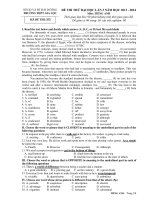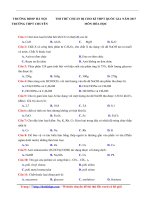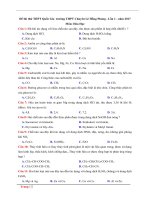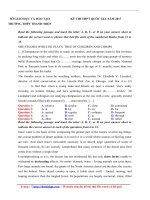- Trang chủ >>
- THPT Quốc Gia >>
- Ngoại Ngữ
THPT chuyen KHTN ha noi mon tieng anh lan 3 nam 2017
Bạn đang xem bản rút gọn của tài liệu. Xem và tải ngay bản đầy đủ của tài liệu tại đây (248.81 KB, 12 trang )
ĐẠI HỌC KHOA HỌC TỰ NHIÊN
KỲ THI THỰC HÀNH THPTQG 2017
TRƯỜNG THPT CHUYÊN KHTN
MÔN THI: TIẾNG ANH
Thời gian làm bài: 60 phút, không kể thời gian phát đề
Mark a letter A, B, C, or D on your answer sheet to indicate the underlined part needs
correction in each of the following questions.
Question 1: Having (A) finished his tem paper (B) before the deadline, (C) it was delivered
to professor (D) before the class
Question 2: I’m (A) very glad that you’ve (B) done (C) lots of (D) progress this semester.
Question 3: You can (A) enjoy a sport (B) without joining (C) in a club or (D) belonging to
a team.
Mark a letter A, B, C, or D on your answer sheet to indicate the most suitable response to
complete each the following exchanges.
Question 4: John: “Do you fancy a drink?”
-Catherine: “______”
A. No, ever!
B. I’m not sure I do. Thank all the same
C. I don’t want
D. It is none of your business
Question 5: “Excuse me, can you tell me where I can catch a bus to London, please?” “______”
A. Sure, go ahead
B. Sorry, I’m new here myself
C. OK. Here’s your ticket
D. Yes, please
Read the following passage and mark the letter A, B, C, or D on your answer sheet to
indicate the correct answer to each of the questions from 6 to 13.
Quite different from storm surges are the giant sea waves called tsunamis, which derive their
name from the Japanese expression for “high water in a harbor.” These waves are also
referred to by the general public as tidal waves, although they have relatively little to do with
tides. Scientists often referred to them as seismic sea waves, far more appropriate in that they
do result from undersea seismic activity. Tsunamis are caused when the sea bottom suddenly
moves, during an underwater earthquake or volcano for example, and the water above the
moving earth is suddenly displaced. This sudden shift of water sets off a series of waves.
These waves can travel great distances at speeds close to 700 kilometers per hour. In the open
ocean, tsunamis have little noticeable amplitude, often no more than one or two meters. It is
when they hit the shallow waters near the coast that they increase in height, possibly up to 40
meters. Tsunamis often occur in the Pacific because the Pacific is an area of heavy seismic
activity. Two areas of the Pacific well accustomed to the threat of tsunamis are Japan and
Trang 1
Hawaii. Because the seismic activity that causes tsunamis in Japan often occurs on the ocean
bottom quite close to the islands, the tsunamis that hit Japan often come with little warning
and can, therefore, prove disastrous. Most of the tsunamis that hit the Hawaiian Islands,
however, originate thousands of miles away near the coast of Alaska, so these tsunamis have
a much greater distance to travel and the inhabitants of Hawaii generally have time for
warning of their imminent arrival. Tsunamis are certainly not limited to Japan and Hawaii. In
1755, Europe experienced a calamitous tsunami, when movement along the fault lines near
the Azores caused a massive tsunami to sweep onto the Portuguese coast and flood the
heavily populated area around Lisbon. The greatest tsunami on record occurred on the other
side of the world in 1883 when the Krakatoa volcano underwent a massive explosion,
sending waves more than 30 meters high onto nearby Indonesian islands; the tsunami from
this volcano actually traveled around the world and was witnessed as far away as the English
Channel.
Question 6: The paragraph preceding this passage most probably discusses _________ .
A. tides
B. storm surges
C. tidal waves
D. underwater earthquakes
Question 7: According to the passage, all of the following are true about tidal waves
EXCEPT that _____ .
A. they are caused by sudden changes in high and low tides
B. this terminology is not used by the scientific community
C. they are the same as tsunamis
D. they refer to the same phenomenon as seismic sea waves
Question 8: The word “displaced” in line 6 is closest in meaning to _________ .
A. not pleased
B. located
C. moved
D. filtered
Question 9: It can be inferred from the passage that tsunamis ________ .
A. are often identified by ships on the ocean
B. generally reach heights greater than 40 meters
C. are far more dangerous on the coast than in the open ocean
D. cause severe damage in the middle of the ocean
Question 10: A main difference between tsunamis in Japan and in Hawaii is that tsunamis in
Japan are more likely to _________ .
A. come from greater distances
B. originate in Alaska
C. arrive without warning
D. be less of a problem
Question 11: A “calamitous” tsunami, in line 17, is one that is _________ .
Trang 2
A. disastrous
B. expected
C. extremely calm
D. at fault
Question 12: From the expression “on record” in line 19, it can be inferred that the tsunami
that accompanied the Krakatoa volcano ___________ .
A. was filmed as it was happening
B. occurred before efficient records were kept
C. was not as strong as the tsunami in Lisbon
D. might not be the greatest tsunami ever
Question 13: The passage suggests that the tsunami resulting from the Krakatoa volcano
A. was unobserved outside of the Indonesian islands
B. resulted in little damage
C. was far more destructive close to the source than far away
D. caused volcanic explosions in the English Channel
Mark a letter A, B, C, or D on your answer sheet to indicate the word(s) CLOSEST in
meaning to the underlined word(s) in each of the following questions.
Question 14: She was brought up in a well-off family. She can’t understand the problem we
are facing.
A. wealthy
B. kind
C. broke
D. poor
Question 15: Father has lost his job, so we’ll have to tighten our belt to avoid getting into
debt.
A. buy new belt
B. sell the belt
C. squander
D. economize
Mark a letter A, B, C, or D on your answer sheet to indicate the word(s) OPPOSITE in
meaning to the underlined word(s) in each of the following questions.
Question 16: She decided to remain celibate and devote her life to helping the homeless and
orphans.
A. divorced
B. married
C. single
D. separated
Question 17: Education is desperately need in many countries with a high percentage of
population being unable to read and write.
A. literate
B. latterly
C. wordy
D. learned
Mark a letter A, B, C, or D on your answer sheet to indicate the word whose underlined
part differs from the offer three in pronunciation in each of the following questions.
Question 18:
Trang 3
A. address
B. canal
C. about
D. cultural
Question 27: I ___ Melisa at my yoga class tonight and will ask her about the plan for this
weekend.
A. will be seeing
B. will have seen
C. will not see
D. will have been seeing
Question 28: Jack and Laure ___ married for 25 years by that time but they still decided to
get divorced.
A. have been
B. were
C. will be
D. had been
Question 29: This orange juice ___ awful: I bet you ___ it,
A. is smelling/ like
B. smelling/ will not like
C. smells/ will not like
D. has smelled/ liked
Question 30: The size and shape of a nail depends primarily on the function ___ intended.
A. which it is
B. for which it is
C. which it is for
D. for which is
Question 31: The ___ friendly products are designed not to harm the natural environment.
Trang 4
A. environment
B. environmental
C. environmentally
D. environmentally
Question 32: He asked me ___ Robert and I did not know ____.
A. that did I know/ who were Robert
B. that I knew/ who Robert were
C. if I knew/ who Robert was
D. whether I knew/ who was Robert
Question 33: Her contract ___ in two months, so she’s looking for another job.
A. runs down
B. runs out
C. goes out
D. goes away
Read the following passage and mark the letter A, B, C, or D on your answer sheet to
indicate the correct word or phases that best fits each of the numbered blanks from 34 to
38.
People have always dreamt of living forever. Although we all know this will never happen,
we will want to live as long as possible.
__(34)__, there are advantages and disadvantages of a long life.In the first place, people who
live longer can spend more time with their family and friends. Secondly, __(35)__have busy
working lives look forward to a long, relaxing life, when they can do the things they‘ve never
had time for.__(36)__, there are some serious disadvantages. Firstly, many people become ill
and consequently have to spend time in hospital or become burden __(37)__ the children and
friends. Many of them find this dependence annoying or embarrassing. In addition to this,
__(38)__ the fewer friends they seem to have because old friends die or become and it’s often
difficult to make new friends.
To sum up, living to a very old age is worthwhile for those who stay healthy enough to
remain independent and enjoy life.
Question 34:
Question 35:
Question 36:
Question 37:
Question 38:
A. Naturally
A. people who
A. In other words
A. of
A. when people
B. Really
B. people
B. For example
B. for
B. when the
C. Consequently
C. people
C. On the other hand
C. to
C. the old people
D. Surprisingly
D. everyone who
D. Contrary to
D. with
D. the older
get older
older people get get
people get
Mark a letter A, B, C, or D on your answer sheet to indicate the sentence that is CLOSEST
in meaning to each of the following questions.
Question 39: Life on earth will be destroyed if people keep cutting trees for their own
benefits.
A. If we stop to cut the trees for our benefits, the life on earth will be better.
B. If we don’t continue to cut trees for our benefits, life on earth will be destroyed.
C. Life on earth will be destroyed unless people stop cutting trees for their own benefits.
D. The more trees we cut for our benefits, the worst the earth becomes.
Trang 5
Question 42: Who is intended to benefit from the advice given in the article?
A. students who have just finished their studies
B. people who are unhappy with their current job
C. those who are interested in establishing a career
D. people who change jobs regularly
Question 43: According to the writer, why is the choice of your second job important?
A. It will affect your future job prospects.
B. It will last longer than your first job.
C. It will be difficult to change if you don’t like it.
D. It should give you the opportunity to study.
Question 44: “It” in the passage refers to_______.
A. first job
B. second job
C. application
D. career
Question 45: If you have a desire to travel, when does the writer suggest that you do it?
Trang 6
A. straight after you have left college
B. when you are unable to find a permanent job
C. after you have done some temporary work
D. between the first and second job
Question 46: What does the phrase “you have got it out of your system” in passage mean?
A. You have planned your career sensibly.
B. You are an experienced traveler.
C. You have satisfied your wish to travel.
D. You have learned to look after yourself.
Question 47: How did Juliette Davidson benefit from the experience of her first job?
A. It was good introduction to working in an office.
B. She met a variety of interesting people.
C. It enabled her to earn enough money to travel.
D. She learnt how to use a word processor.
Question 48: In what way is Juliette’s current job better her first job?
A. She has a more impressive job title.
B. She now know how to start her own business.
C. She has been able to extend her skills.
D. She is more involve in the community.
Mark a letter A, B, C, or D on your answer sheet to indicate the sentence that best
combines each pair sentences in the following questions.
Question 49: The student works part-time at a bid restaurant. He also paints pictures to earn
for living.
A. Apart from works part-time at a bid restaurant, the student also paints pictures to earn for
living.
B. In addition working part-time at a big restaurant, the student also paints pictures to earn for
living.
C. Besides working part-time at a big restaurant, the student also paints pictures to earn for
living.
D. The student works part-time at a big restaurant as well as he paints pictures to earn for
living.
Question 50: The buses began to pull out. Most of them were full passengers.
A. The passengers, most of them were full of, began to pull out the buses.
B. The passengers, most of whom were full of the buses, began to pull out.
Trang 7
C. The buses, most of them were full of passengers, began to pull out.
D. The buses, most of which were full of passengers, began to pull out.
Trang 8
Đáp án
1-C
11-A
21-A
31-C
41-A
2-B
12-D
22-B
32-C
42-C
3-C
13-C
23-B
33-B
43-A
4-B
14-A
24-C
34-A
44-B
5-B
15-D
25-B
35-A
45-D
6-B
16-B
26-A
36-C
46-C
7-A
17-A
27-A
37-C
47-A
8-C
18-B
28-D
38-D
48-C
9-C
19-A
29-C
39-C
49-C
10-C
20-A
30-B
40-B
50-D
LỜI GIẢI CHI TIẾT
Question 1: Đáp án C
It was delevered => he delivered it
Vì mệnh đề đầu dùng mệnh đề rút gọn Having finished nên đây phải là hai mệnh đề cùng chủ
ngữ mang nghia chủ động [ he]
Câu này dịch như sau: Sau khi anh ấy hoàn thành xong bài báo cáo học kỳ trước hạn chót ,
anh ấy nộp cho giáo sư trước lớp.
Question 2: Đáp án B
done => made Vì cụm từ make lots of progress: có nhiều tiến bộCâu này dịch như sau: Tôi
rất vui rằng bạn có nhiều tiến bộ trong học kỳ này.
Question 3: Đáp án C
In => bỏ giới từ “in”
Vì bản thân động từ “join” [ tham gia vào] không cần giới từ.
Câu này dịch như sau: Bạn có thể thường thức một môn thể thao mà không cần tham gia vào
câu lạc bộ hay thuộc về một đội nào.
Question 4: Đáp án B
John: “ Bạn muốn uống gì không?”A. Không, chưa bao giờ.B. Tôi không chắc có muốn hay
không, cảm ơn tất cả.C. Tôi không muốn.D. Không phải việc của bạn.
Question 5: Đáp án B
- “ Xin lỗi bạn có thể cho tôi biết tôi có thể đón xe buýt đến Luân Đôn ở đâu không?”
A. Chắc chắn rồi. Cứ làm đi.
B. Xin lỗi, tôi mới đến đây.
C. Được rồi. Vé của bạn đây.
D. Vâng, làm ơn.
Question 6: Đáp án B
Đoạn văn trước bài đọc này có thể thảo luận về...?Tides: thủy triềuStorm surges: những đợt
bão nổi lênTide wave: sóng thủy triềuUnderwater earquakes: những trận động đất dưới đại
Trang 9
dươngDẫn chứng: Quite different from storm surges are the giant sea waves called tsunamis,
which derive their name from the Japanese expression for “high water in a harbor.”
Question 7: Đáp án A
Theo bài đọc tất cả ý nào sau đây đúng về sóng thủy triều NGOẠI TRỪ
A. Chúng được gây ra bởi sự thay đổi đột ngột của thủy trều cao và thấp.
B. Thuật ngữ này không được sử dụng trong giới khoa học
C. Chúng giống như sóng thần
D. Chúng ám chỉ đến cùng một hiện tượng như những con sóng biển địa chấn
Dẫn chứng: Tsunamis are caused when the sea bottom suddenly moves, during an underwater
earthquake or volcano for example, and the water above the moving earth is suddenly
displaced.
Question 8: Đáp án C
Từ “ di dời/ chuyển chỗ” ở đoạn 2 gần nghĩa nhất với
Not pleased: không hài lòn
Located: định vị/ dặt để
Moved: di chuyển
Filtered: lọc
=>displaced = moved
Question 9: Đáp án C
Có thẻ suy ra từ bài đọc rằng sóng thần
A. thường được xác định bởi những con tàu trên đaị dương
B. thường đạt độ cao lớn hơn 40 mét
C. thường nguy hiểm hơn khi ở ven bờ so với ngoài đại dương.
D. thường gây ra thiệt hại nghiêm trọng giữa đại dương
Dẫn chứng: In the open ocean, tsunamis have little noticeable amplitude, often no more than
one or two meters. It is when they hit the shallow waters near the coast that they increase in
height, possibly up to 40 meters
Question 10: Đáp án C
Sự khác nhau giữa sống thần ở Nhật Bản và ở Hawaii là sóng thần ở Nhật thì
A. đến từ khoảng cách xa hơn
B. có nguồn gốc từ Alaska
C. đến mà không có cảnh báo
D. là vấn đề ít hơn
Trang 10
Dẫn chứng: Because the seismic activity that causes tsunamis in Japan often occurs on the
ocean bottom quite close to the islands, the tsunamis that hit Japan often come with little
warning and can, therefore, prove disastrous.
Question 49: Đáp án C
Học sinh này làm việc bán thời gian tại mô nhà hàng lớn. Anh ấy cũng vẽ tranh để kiếm sống.
A. Câu A sai ngữ pháp vì apart from + Ving
B. Câu B sai ngữ pháp vì in addition to + Ving/ hoặc In addition, S + V
C. Bên cạnh làm việc bán thời gian tại nhà hàng lớn, học sinh này cũng vẽ tranh để kiếm
sống.
D. Học sinh này làm việc bán thời gian tại nhà hàng lớn cũng như anh ấy vẽ tranh để kiếm
sống. => loại vì câu dài dòng, rườm rà chỉ nên viết “ The student works part-time at a big
restaurant as well as paints pictures to earn for living.”
Question 50: Đáp án D
Trang 11
Các xe buýt bắt đầu lăn bánh. Hầu hết đều đầy hành khách.
A. Những hành khách, hầu hết trong số họ đều đầy, bắt đầu lăn bánh xe buýt.
B. Những hành khách, hầu hết trong số họ đều đầy, bắt đầu lăn bánh xe buýt.
C. Những chiếc xe buýt, hầu hết chúng đều đầy hành khách, bắt đầu lăn bánh. => loại vì liên
kết hai mệnh đề với nhau phải dùng đại từ quan hệ “ which”
D. Những chiếc xe buýt, hầu hết chúng đều đầy hành khách, bắt đầu lăn bánh. => dùng most
of which để thay thế cho “ the buses”
Eroguseriotv
ueriobyjserotvjerm90buyjmuu6490uitv523490k34icr-
04itv90utcrik3490tvukci3vikc-0ewiltv-0itvktcrl234ict34tvbkyeyhserhasegh
Eroguseriotv
ueriobyjserotvjerm90buyjmuu6490uitv523490k34icr-
04itv90utcrik3490tvukci3vikc-0ewiltv-0itvktcrl234ict34tvbkyeyhserhasegh
Trang 12









